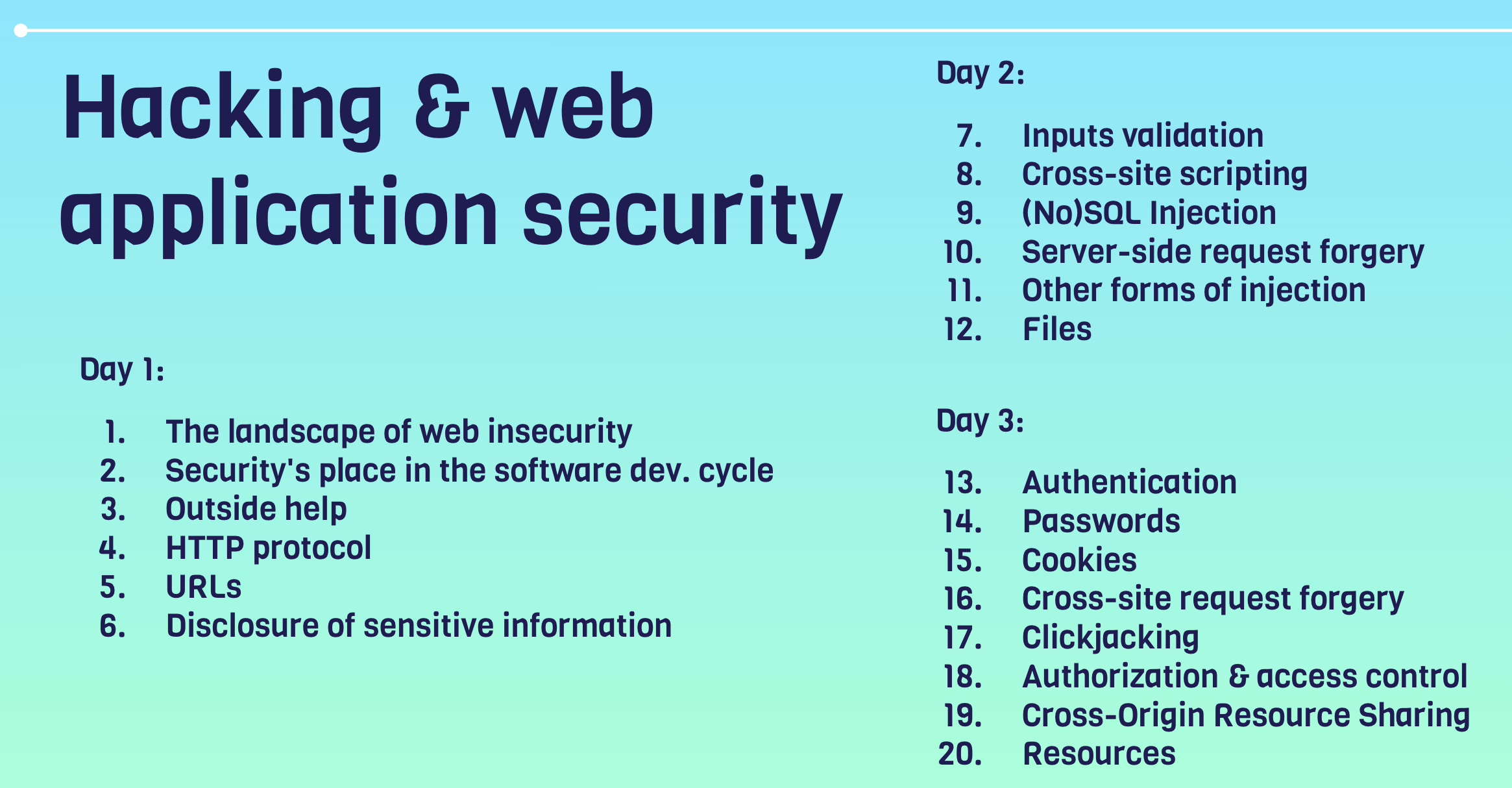Hacking & web application security
This intensive 3-day training is designed for developers and system administrators aiming to enhance the security of their web applications. Combining theoretical knowledge with practical exercises, the course covers common vulnerabilities, utilization of essential tools, best practices in secure web development. Participants will learn to identify, exploit, and remediate security flaws, gaining hands-on experience to proactively defend against real-world threats.

Targeted audience:
- Web developers
- System administrators
- Dev(Sec)Ops engineers
- Any cybersecurity enthusiasts
Educational goals:
- Understand the main web application vulnerabilities
- Learn how to detect and exploit common security flaws
- Use tools like Burp Suite and SQLmap effectively
- Apply secure coding practices to prevent attacks
- Improve overall application resilience against threats
Prerequisites:
- Basic knowledge of web development (HTML, CSS, JavaScript)
- Familiarity with web protocols (HTTP, HTTPS)
- Experience with using command-line tools
Program:
Day 1 - The basics of web security
The landscape of web insecurity
- Web security: a vast topic
- Architecture of a typical Web app
- Open Web Application Security Project (OWASP)
- CWEs, CVEs & CVSS
- External and internal attackers
- The different steps of an attack
- An attacker’s bag of tricks
- Common misconceptions
Security’s place in the development cycle
- The importance of inventory
- Shadow IT
- Production bias & incompatibility with Agile approaches
- The idea of DevSecOps
- The importance of testing & code reviews
- Static & dynamic analysis
Outside help
- Security audits and Bug Bounty
- Vulnerability disclosure policy
HTTP protocol
- Reminder about the HTTP(s) protocol
- Anatomy of HTTP requests & responses
- Semantics & status codes
- Introduction to Dev Tools
- Introduction to Burp Suite
URLs
- Anatomy of a URL
- Open redirects exploitation
Disclosure of sensitive information
- Sequential IDs
- Verbose error messages
- Directory listing
- Clear-text logging of sensitive information
- Secrets on the client side
- API Excessive data exposure
- Public Git repositories & history
- Git directory deployed
Day 2 - User input flaws
Input validation
- Client-side, server-side, or both?
- HTTP parameter pollution
- Mass assignment
Cross-Site Scripting (XSS)
- Cross-site scripting is everywhere
- Types of cross-site scripting
- What is the impact?
- How to protect & how to bypass
SQL Injection (SQLi)
- What is it?
- What is the impact?
- How to protect & how to bypass
- Presentation of SQLMap
- NoSQL injection
Content Security Policy (CSP)
- Definition
- Most common directives
- Possible configuration
- What is the impact?
- How to protect & how to bypass
Other forms of injection
- HTML injection
- Code injection
- OS command injection
Files
- Common file issues
- Arbitrary file upload
- Path traversal
- Local & remote file inclusion
Day 3 - Authenticated user vulnerabilities
Authentication & vulnerabilities
- Authentication
- User enumeration
- Rate limiting and security questions
- Multiple-factor authentication
Passwords
- Cryptography in a nutshell: encoding, hashing, encryption
- Password-strength policy
- Leaked passwords
- Password storage
- Cracking tools
Cookies
- Cookies attributes: secure, httponly, domain, samesite…
- Session hijacking
Cross-Site Request Forgery (CSRF)
- What is it?
- What is the impact?
- How to protect & how to bypass
Clickjacking
- What is it?
- What is the impact?
- How to protect & how to bypass
Authorization & access control
- Authentication vs. authorization
- Roles and permissions
- Insecure direct object reference
Cross-Origin resource sharing (CORS)
- Refresher on the Same-Origin Policy
- Possible misconfigurations
- What is the impact?
- How to protect
Gwendal Le Coguic - contact@glc.st - quotes on request - SIRET 79778302400038







